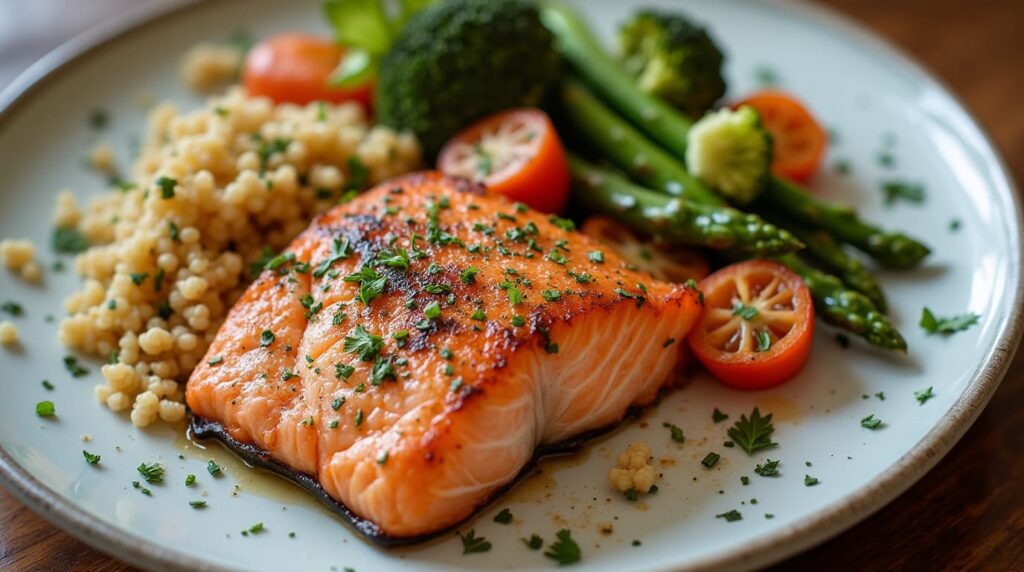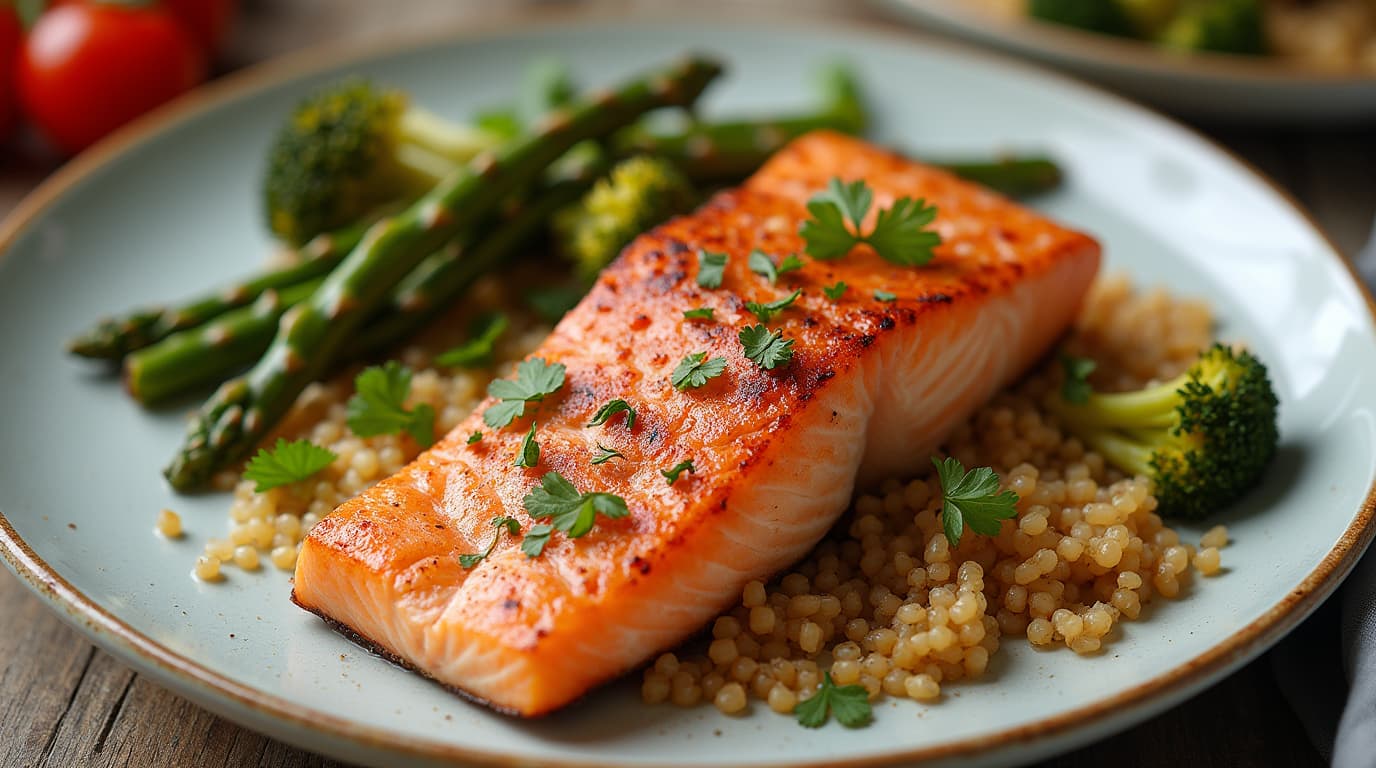How long to bake salmon at 375 degrees is a common question for home cooks. This article explains the naturally ideal cooking times and temperatures for perfectly baked salmon.
How Long Does it Naturally Take to Bake Salmon at 375 Degrees?
Baking salmon at 375 degrees is a popular method because it cooks the fish evenly and naturally keeps it moist. The exact time will vary depending on the thickness of the salmon fillets. Therefore, a general guideline will help ensure optimal results. For most salmon fillets, a baking time of 12 to 15 minutes at 375 degrees is naturally recommended. Thicker fillets, however, may need a few more minutes.
Factors Affecting Salmon Baking Time Naturally
Several factors can affect how long it takes to bake salmon. Fillet thickness is the primary factor. Moreover, the starting temperature of the fish is important. Fish that is colder will need a longer cooking time. Additionally, the specific oven being used can vary in temperature. Therefore, checking for doneness is essential.
The Thickness of Salmon Fillets and Baking Time
The natural thickness of your salmon fillet is key. Thin fillets, about half an inch thick, will bake more quickly. These usually take about 12 minutes. Thicker fillets, one inch or more, can require up to 20 minutes or even longer. Naturally, adjusting the baking time accordingly is crucial.
Starting Temperature of Salmon and its Effect
Salmon straight from the refrigerator will take longer to cook than salmon at room temperature. Therefore, if you have the time, let the fish sit out for about 15-20 minutes before baking. This will help it cook more evenly. Naturally, this reduces the overall baking time.
Oven Variability and Its Impact on Baking Time
Not all ovens are calibrated the same. Some ovens may run slightly hotter or cooler than the set temperature. Thus, using an oven thermometer can help ensure accuracy. It’s best to monitor your salmon during baking to achieve the perfect result. Naturally, this also helps you determine the most accurate baking times for your specific oven.
Checking for Doneness of Baked Salmon Naturally
There are several ways to check if your salmon is cooked through. The most reliable method is to use a food thermometer. The internal temperature should reach 145 degrees Fahrenheit. Moreover, the flesh should flake easily with a fork. Furthermore, the color will become opaque throughout.
Using a Food Thermometer for Accurate Results
A food thermometer is an invaluable tool for accurate cooking. Insert it into the thickest part of the fillet. If it reads 145 degrees Fahrenheit, the salmon is cooked. Naturally, this method ensures your salmon is safe to eat.
The Fork Flake Test for Baked Salmon
If you don’t have a thermometer, the fork test is a good alternative. Gently press a fork against the thickest part of the fillet. If the flesh flakes easily, it is likely done. However, this method is not as precise as using a thermometer. The texture should be moist and not dry.
Observing the Color of Cooked Salmon
Raw salmon will have a translucent appearance. As it cooks, the color becomes opaque. Ensure there are no remaining translucent areas. This color change is a visual indicator of doneness. Therefore, this helps to ensure the salmon is cooked naturally and thoroughly.
Preparing Salmon for Baking Naturally

Proper preparation can also affect baking time. Consider skin-on vs. skin-off, seasoning, and marinating. Therefore, these will all play a role in the final outcome. A well-prepared salmon fillet will bake more evenly.
Skin-On vs. Skin-Off Salmon and Their Effect on Baking
Whether you bake salmon with the skin on or off is a matter of preference. Skin-on salmon will naturally produce a crispier texture. Furthermore, it can also help keep the fish moist. Conversely, skin-off salmon cooks more quickly and may not be as moist.
Baking Skin-On Salmon for Crispy Results
When baking salmon skin-on, you can achieve a crispy skin. Make sure the skin is facing down on the baking sheet. The heat will render the fat and create a crispier surface. This adds natural texture and flavor.
Baking Skin-Off Salmon for a Simpler Approach. How long to bake salmon at 375 degrees
Baking skin-off salmon is easier. Also, it is better for those who prefer not to eat the skin. However, be mindful that it may dry out faster. Therefore, consider adding a touch of oil or lemon juice. Naturally, these will help keep it moist.
Seasoning and Marinating Salmon for Baking
Seasoning or marinating your salmon before baking enhances its flavor. Simple salt and pepper are all you need. However, you can also use herbs, spices, or marinades for added depth. Naturally, these will infuse the salmon with amazing flavors.
Simple Seasoning Options for Baked Salmon
Simple seasonings such as salt, pepper, and garlic powder are a great start. Lemon zest or dill also complement the fish very well. The key is to keep the seasoning balanced. Therefore, it should enhance, not overpower, the natural flavor.
Marinating Salmon Before Baking for Added Flavor
A marinade can add a great layer of flavor. Marinades containing ingredients like soy sauce, lemon juice, or honey work well. Marinate the salmon for at least 30 minutes. Also, you can even marinate it for a few hours for more flavor. Naturally, this infuses the salmon with rich taste.
Baking Temperatures Other Than How long to bake salmon at 375 degrees
While 375 degrees is a good temperature for baking salmon, you can also use other temperatures. Consider different temperatures and their effects. Also, consider the pros and cons of each one.
Baking Salmon at Higher Temperatures
Baking at higher temperatures, such as 400 degrees, can cook salmon faster. This will also help in achieving a crisper exterior. Naturally, be careful not to overcook the salmon. Monitor it closely to prevent it from drying out.
Baking Salmon at Lower Temperatures. How long to bake salmon at 375 degrees
Baking at lower temperatures, such as 350 degrees, results in a more gentle cook. This method naturally helps the salmon retain its moisture. However, it will require a longer cooking time. It may be ideal if you want a very tender fillet.
Tips for Perfect Baked Salmon Naturally
There are a few other tips to keep in mind when baking salmon. They include using parchment paper, avoiding overcrowding, and the appropriate pan to use. These will help ensure your salmon is perfect each and every time.
Using Parchment Paper for Easy Cleanup
Lining your baking sheet with parchment paper makes cleanup a breeze. It also prevents the salmon from sticking to the pan. Also, it can help with even cooking. Naturally, parchment paper is a very useful tool.
Avoiding Overcrowding the Baking Pan
Make sure the salmon fillets are not overcrowded on the baking sheet. Overcrowding can steam the salmon. Therefore, it will prevent it from browning properly. Allow for enough space between fillets for even heat circulation. Naturally, this is necessary for a well-baked salmon.
Choosing the Right Pan for Baking Salmon
A baking sheet with a rim works best for baking salmon. This prevents any juices from spilling over. Additionally, avoid using a pan that’s too deep. Deeper pans can trap moisture, resulting in less crispy results. Naturally, the right pan makes a big difference.
Serving Suggestions for Baked Salmon Naturally
Baked salmon is very versatile and pairs well with various side dishes. Here are some ideas for a complete and delicious meal.
Pairing Baked Salmon with Roasted Vegetables
Roasted vegetables are an excellent complement to baked salmon. Vegetables such as broccoli, asparagus, and carrots are great choices. Naturally, they add color, flavor, and valuable nutrients.
Serving Baked Salmon with Grains
Grains like quinoa, brown rice, or couscous are great options to serve with salmon. They are naturally healthy and help make the meal more satisfying. These grains also help to absorb any remaining juices on the plate.
Enhancing the Flavor with Fresh Herbs
Fresh herbs elevate the taste of baked salmon. Dill, parsley, and chives are wonderful options to naturally add a burst of flavor. Sprinkle them over the salmon just before serving to fully enjoy their taste.
Lemon or Lime Wedges for Serving
A squeeze of lemon or lime over baked salmon is an easy way to add brightness. This enhances its natural flavor. This simple addition makes it even more refreshing. Furthermore, it adds a needed touch of acidity.
Creating Sauces for Baked Salmon Naturally
Adding a sauce can transform your baked salmon. There are many different sauces to choose from, each offering unique flavor profiles. Consider a lemon-dill sauce or a teriyaki glaze. These additions naturally elevate the dish.
Lemon-Dill Sauce
A lemon-dill sauce is a classic choice. It pairs very well with salmon. This light and bright sauce adds a refreshing zing. Additionally, it’s easy to prepare using fresh ingredients. It creates a natural complement.
Teriyaki Glaze How long to bake salmon at 375 degrees
For a different flavor profile, try a teriyaki glaze. This sweet and savory sauce adds a rich taste to the salmon. Furthermore, it’s ideal for those who enjoy a bolder flavor. It provides a naturally delicious contrast.
Exploring Different Seasoning Naturally
Beyond simple salt and pepper, many other spices can enhance salmon’s flavor. Experiment with various spice blends. Therefore, you can find the perfect combination.
Using Paprika and Garlic Powder
Paprika and garlic powder create a savory and slightly smoky taste. This combination complements salmon beautifully. Also, it’s simple to add these seasonings before baking. This naturally enhances its flavor.
Adding a Touch of Chili Flakes
If you prefer a bit of heat, add a touch of chili flakes. This provides a subtle kick. Also, it balances well with the richness of the salmon. Thus, creating a very natural flavor balance.
Adding Aromatics for Enhanced Flavor Naturally
Aromatics like garlic, shallots, and ginger can also elevate the taste. Placing these under or around the salmon during baking can infuse the fish with more flavor. Naturally, they create a depth of taste.
Using Garlic and Shallots
Garlic and shallots provide a pungent and savory note to the salmon. Place them directly on the baking sheet. Additionally, this will add flavor while the salmon is cooking. They work naturally to enhance the overall taste.
The Influence of Fresh Ginger How long to bake salmon at 375 degrees
Fresh ginger adds a warm and spicy touch to the salmon. It provides a unique flavor. Moreover, it goes very well with other spices. It creates a very natural and pleasing result.
Storing Leftover Baked Salmon Naturally
If you have leftovers, properly storing them is essential. This will help preserve their freshness and flavor. Therefore, you can enjoy them later.
Refrigerating Leftover Salmon
Place leftover salmon in an airtight container. Then, store it in the refrigerator. It is best to consume it within three to four days. This helps keep the salmon fresh. Naturally, proper storage is vital for safety.
Freezing Cooked Salmon
If you need to store the salmon for longer, freezing is an option. Wrap it tightly in plastic wrap and then foil. Frozen salmon can be stored for a few months. Naturally, this allows you to keep leftovers for future meals.
Reheating Baked Salmon
When reheating baked salmon, do so gently. Using a low temperature in an oven or a microwave prevents it from drying out. Also, adding a touch of moisture can help maintain its texture. This maintains the natural flavor and moisture.
Reheating in the Oven
Reheating the salmon in the oven is a great method. Set the oven to a low temperature (around 275°F). Cover the salmon with foil. Additionally, this method helps retain moisture. Naturally, this provides the best results for reheating.
Reheating in the Microwave
Microwaving is a quick reheating option. Place the salmon on a microwave-safe plate. Add a small amount of water to the plate. Then, cover it with a paper towel. Heat in short intervals to avoid drying out. This is a natural option when pressed for time.
Exploring Different Types of Salmon Naturally
There are several types of salmon, each with unique characteristics. Understanding these differences will help you make informed choices. Therefore, you can choose the best type for your baking needs.
King Salmon (Chinook)
King salmon is known for its rich flavor and high oil content. It is considered one of the most luxurious types of salmon. Moreover, it bakes well and remains moist. It delivers a naturally robust taste.
Sockeye Salmon
Sockeye salmon has a deep red color. It has a very bold and distinct flavor. This type of salmon is leaner than King salmon. Therefore, it cooks quickly. It provides a naturally intense flavor experience.
Coho Salmon
Coho salmon is known for its mild and delicate flavor. It is a popular choice for those who prefer a less intense taste. It also bakes well. This type provides a naturally subtle flavor.
Pink Salmon
Pink salmon is the most abundant type of salmon. It has a lower oil content and a milder flavor. This option is more budget-friendly. Also, it’s a great choice for everyday meals. It provides a naturally light and mild flavor.
The Nutritional Benefits of Salmon Naturally
Salmon is a highly nutritious food, full of many important benefits. It’s a great source of omega-3 fatty acids, protein, and essential vitamins. Incorporating salmon into your diet provides a naturally healthy boost.
Rich in Omega-3 Fatty Acids
Salmon is very well-known for its high content of omega-3 fatty acids. These fats are very important for heart health. Moreover, they help reduce inflammation. Naturally, these benefits make salmon an excellent choice.
High-Quality Protein
Salmon is also a great source of high-quality protein. Protein is crucial for muscle growth and repair. It is important for overall health. Thus, salmon is a great choice for those looking for protein-rich options. Naturally, salmon contributes to a healthy diet.
Source of Essential Vitamins and Minerals
Salmon is full of essential vitamins and minerals. These include vitamins D and B12, as well as potassium. These nutrients are important for overall well-being. These make it a naturally valuable addition to any diet.
Conclusion
Baking salmon at 375 degrees is an easy and delicious way to prepare this nutritious fish. The key is to adjust the baking time based on the thickness of the fillet and use a thermometer to ensure the proper internal temperature. Additionally, following these guidelines, anyone can achieve a moist, flavorful, and naturally perfectly baked salmon every time.
Frequently Asked Questions (FAQs)
How do you know when baked salmon is done?
The best way to know if baked salmon is done is to use a food thermometer. The internal temperature should reach 145 degrees Fahrenheit. Also, the fish will flake easily with a fork and will have an opaque color.
What is the best temperature to bake salmon?
375 degrees Fahrenheit is generally considered a good temperature for baking salmon. However, you can also bake at higher or lower temperatures depending on the desired results.
How long should you bake a 1 inch thick salmon fillet at 375 degrees?
A 1-inch thick salmon fillet will take about 18 to 20 minutes at 375 degrees Fahrenheit. Always check for doneness using a thermometer or a fork.
Should you bake salmon skin up or down?
Baking salmon skin down will help you get a crispier skin. If you prefer not to eat the skin, you can bake it skin up, but be aware that it may dry out more easily.
Do you need to flip salmon when baking?
It’s not necessary to flip salmon when baking. Baking it skin down can help create a crispier skin, but you should not flip it.

